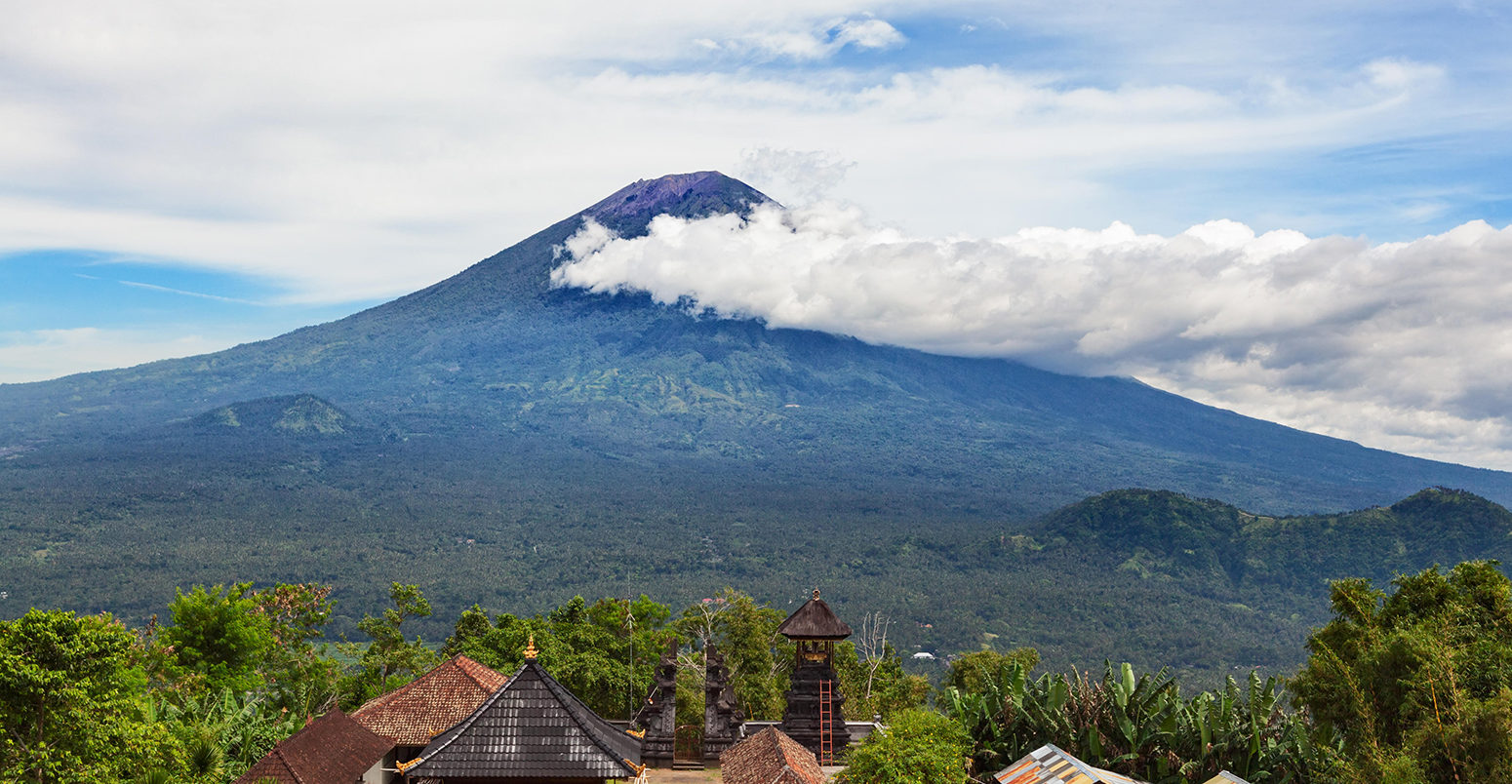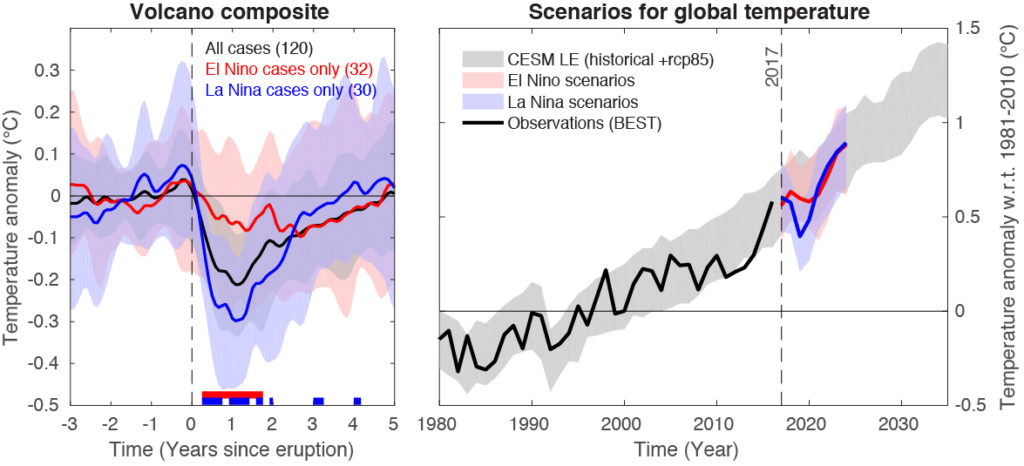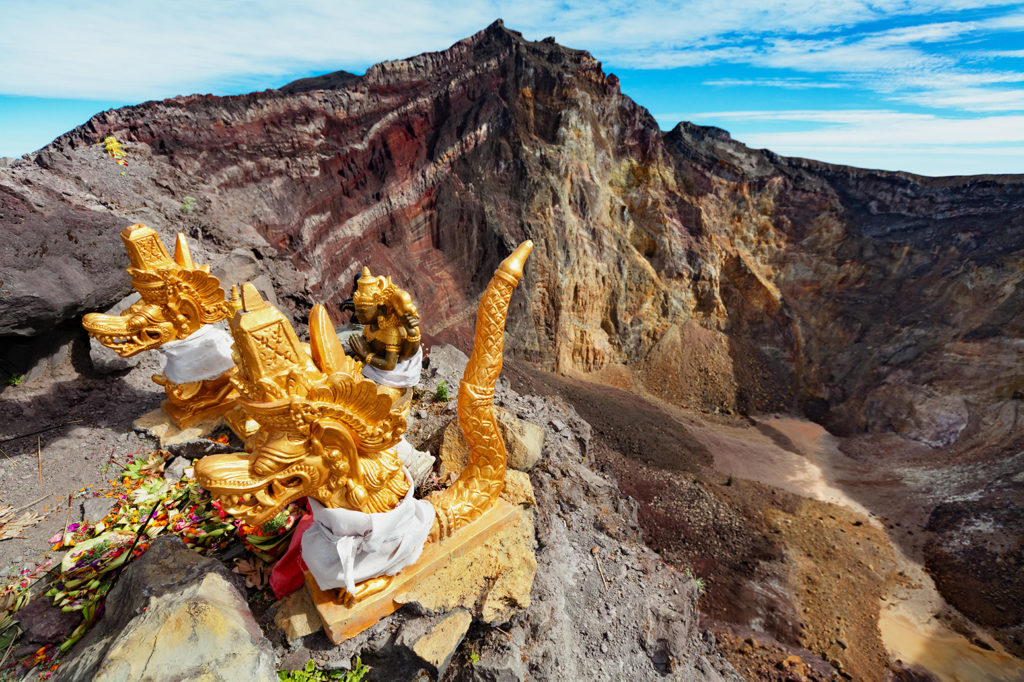
Analysis: How could the Agung volcano in Bali affect global temperatures?
Zeke Hausfather
10.25.17Zeke Hausfather
25.10.2017 | 4:08pmWhile human activity has been the dominant driver of climate change over the past century, natural factors can influence short-term variations in global temperature.
Major volcanic eruptions, in particular, can have a sizable cooling impact on the climate lasting for five years or so.
The Mount Agung volcano in Bali, Indonesia, has been showing signs that an eruption is likely to occur this year. Last time Agung erupted, back in 1963, it had a noticeable cooling effect on the Earth’s climate.
Here, Carbon Brief examines how volcanoes influence the climate, and suggests that a new Agung eruption would likely only result in a modest and temporary cooling of global temperatures.
Volcanoes and climate change
Volcanoes generally have a cooling influence on the Earth’s surface.
Eruptions send a cloud of ash and dust high into the atmosphere. The sulphur dioxide released combines with water to form sulfuric acid aerosols, which reflect incoming sunlight and influence cloud formation. When eruptions are powerful enough to reach the stratosphere (18 km or more above the surface at the equator), these sulphate aerosols can stay aloft for a number of years and have a strong cooling effect on the climate.
Volcanic eruptions also release CO2 into the atmosphere, meaning they contribute to warming by strengthening the greenhouse effect. But this influence is very small, and is outweighed by the cooling impact of the dust and ash.
The location of volcanoes also matter. Major volcanic eruptions near the equator are more likely to have a big effect on global temperatures, while high-latitude eruptions (like Laki) will have their effects more limited to the one hemisphere. Sulphate aerosols from high-latitude volcanoes generally will not cross the equator, while tropical volcanoes tend to cool both hemispheres.
The figure below shows an example of what might happen if the Agung erupted today.
The black dots represent the actual measured temperatures (from Berkeley Earth), while the grey shaded areas show the three major volcanic eruptions since 1960 (Agung, El Chichon, and Pinatubo). The red line shows Carbon Brief’s estimate of the warming that can be attributed to the combination of greenhouse gases, volcanoes, and changes in solar output, and blue dip after 2016 shows what could happen to global temperatures if the expected Agung eruption is of the same magnitude as the one that occurred in 1963.
Global mean surface temperatures from Berkeley Earth (black dots), major volcanoes (shaded areas), and estimated temperatures based on human and natural radiative forcing (red) with a 1963-size Agung eruption in mid-2017 (blue). The baseline period is 1961-90. See methods at end of article for details. Chart by Carbon Brief using Highcharts.This projection, which is based on the historical relationship between volcanic eruptions and temperature, suggests that an Agung eruption would reduce global temperatures between 0.1C to 0.2C in period from 2018 to 2020, with temperatures mostly recovering back to where they otherwise would be by 2023.
There is no guarantee that an eruption of Agung today would be the same size as the one in 1963, however. A small volcanic eruption that doesn’t reach the stratosphere would have a relatively minor climate impact, as sulphur dioxide from the volcano would quickly fall out of the atmosphere.
On the flip side, we have records of much larger volcanic eruptions, such as Tambora in 1815 that may have cooled the globe by 0.6C or more and led to the “year without a summer”. Even in large eruptions this cooling only lasts a few years, however, as once sulphate aerosols eventually fall back to earth the climate quickly returns to normal.
How much will temperatures actually change?
The change in temperatures after the eruption is hard to predict precisely, partly because we don’t yet know what impact the El Niño-Southern Oscillation (ENSO) will have on the climate over the coming decade.
While a response of around 0.2C is expected in neutral ENSO conditions, if the eruption happens to overlap a sizable warm El Niño event or a large cool La Niña event, the impact could be quite different.
To determine exactly how ENSO and volcanoes could interact, researchers at the US National Center for Atmospheric Research (NCAR) have undertaken an analysis using the Community Earth System Model (CESM) Large Ensemble (LE). The CESM LE is a set of 40 different simulations of the same advanced climate model, with only very small differences in initial conditions. The long-term changes are the same in all the model runs, but emergent short-term variability – such as ENSO – differs for each.
The NCAR researchers used the CESM LE to look at the average temperature effect recent major volcanic eruptions: Agung in 1963, El Chichon in 1982, and Pinatubo in 1991, which you can see in black line the left-hand chart below. They found 58 model runs where El Niño conditions were neutral after the eruption. They also identified 32 cases where an El Niño followed the eruption (red line), and 30 cases where a La Niñ followed the eruption (blue line).

Mean temperature response in the CESM LE after Agung, El Chichon, and Pinatubo eruptions by ENSO condition (left). Estimated impact of a 2017 Agung eruption (of the same magnitude as the prior eruption) by ENSO condition (right), along with observations from Berkeley Earth. Figure from Lehner and Fasullo.
When eruptions occurred, the average cooling was about 0.2C, with most of the effect dissipating over five years as sulphate aerosols fell out of the stratosphere. When volcanoes were followed by an El Niño event in the models, however, the average cooling was only around 0.1C or less, while volcanoes followed by La Niña events saw an average cooling of 0.3C or more.
Projections of temperature change from an Agung eruption of a similar magnitude to the one in 1963 coinciding with either an El Niño (red) or La Niña (blue) are shown in the right panel. If the eruption coincides with an El Niño event, there may be little to no detectable cooling depending on the size of the eruption. However, if the eruption coincides with a La Niña event, we could witness substantial cooling based on the combination of the two.
Barring an eruption of the magnitude not seen for over 200 years, however, the total effect on the Earth’s temperature will be relatively small compared to the warming experienced over the past century.

Shrine on the brink of the crater of Mount Agung, an active volcano, with traditional offering for spirits protecting against eruption, 02/08/2012 Credit: Denis Moskvinov/Alamy Stock Photo.
An Agung eruption similar to 1963 would only reduce temperatures for 2018 down to 2014 levels, all things being equal. It might postpone the date when a new record is set for the warmest year in recorded history, but it will not affect long-term warming driven by increasing atmospheric greenhouse gas concentrations.
Methodological note
A variant of Otto et al. (2015) method was used to estimate the efficacy of human and natural radiative forcing on global average surface temperature using a multivariate regression model. The regression model fit observed surface temperatures using both total anthropogenic forcings (greenhouse gases + aerosols) and natural forcings (volcanoes + solar). Thermal response times were adjusted for volcanic forcings to allow a more immediate impact of aerosol cooling.
Forcings were fit to a variant of the Berkeley Earth surface temperature record that had ENSO removed (as per the Foster & Rahmstorf (2011) method). Removing ENSO from the record before fitting forcings is necessary to accurately assess the magnitude of temperature response to volcanic forcing due to the overlap of volcanoes with ENSO events.
An Agung eruption scenario was created by assuming that the volcanic aerosol radiative forcings of the 1963-1966 occur from 2017-2020. Radiative forcing data was obtained from Meinshausen et al. (2011), with data available here.
-
Analysis: How could the Agung volcano in Bali affect global temperatures?

